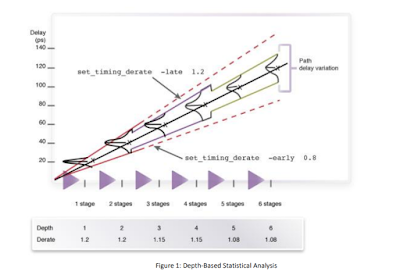During CTS we often see multiple clocks getting balanced. Sometimes we also find clocks which are not be balanced getting balanced by the CTS engine.
CTS engine tries to balance the clocks based upon all the clocks reaching the end point or sink pin
Step1 : Get all the clocks reaching the path with high latency sink pin using the following sink pin.
Step2: identify muxes in the clock path
Step3: check clocks on b pin
Step4: check clocks on a pin
step5: check the case value on the mux sel pin
If there is no definition of the case_value on the sel pin. Then ideally there should have been two generated clocks defined on the output of the z pin and defined logically asynchronous to resolve the issue.
Check all clocks on the sink pin
pt_shell> get_attribute [get_pins {module/u_cmux2_SIZE_ONLY/z} ] clocks
{"CLKM1_long_latency_clk", "CLKM1_main_clk"}
report the clock path using the below clock and identify mux in the path by reporting the problematic clock
report_clock_timing -to {mux/reg[1]/clk} -type latency -clock main_clock -verbose
Check the clocks on b pin of mux
pt_shell> get_attribute [get_pins
{module/u_cmux2_SIZE_ONLY/b}
] clocks
{"CLKM1_main_clk"}
Check clocks on a pin of the mux
pt_shell> get_attribute [get_pins
{module/u_cmux2_SIZE_ONLY/a}
] clocks
{"CLKM1_long_latency_clk"}
Check case value on the mux ( If the case value is not defined then both clocks get propagated
pt_shell> get_attribute [get_pins
{module/u_cmux2_SIZE_ONLY/sel}
] case_value
==> no case value defined
create the generated clocks at the mux output with the two clocks on A pin and B pin
create_generated_clock -name CLKM1_main_clk_DIV1 -source [get_ports \
{main_port}]
-divide_by 1 -add -master_clock [get_clocks {CLKM1_main_clk}]
[get_pins -hsc module/u_cmux2_SIZE_ONLY/z}]
create_generated_clock -name long_latency_clk_DIV1 -source [get_ports \
{main_port}]
-divide_by 1 -add -master_clock [get_clocks {CLKM1_long_latency_clk}]
[get_pins -hsc module/u_cmux2_SIZE_ONLY/z}]
set_clock_groups -logically_exclusive -group [get_clocks CLKM1_main_clk_DIV1 ] -group [get_clocks CLKM1_long_latency_clk ]
Issue fixed ? Share your thoughts on how else can we fix this issue and ways of debugging. Pros and cons of those ways of fixing.






